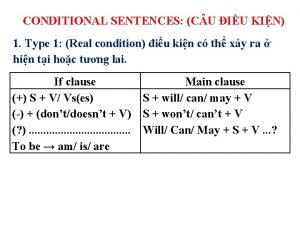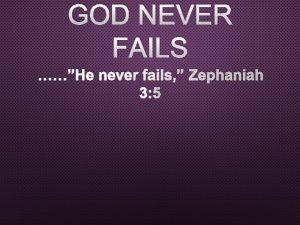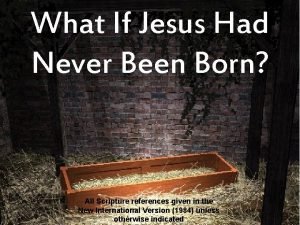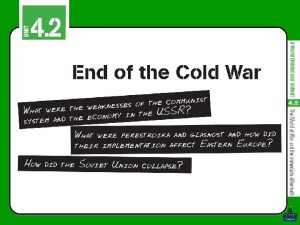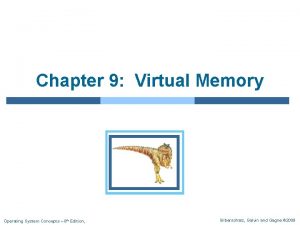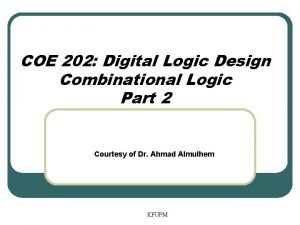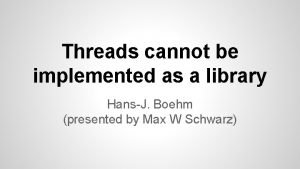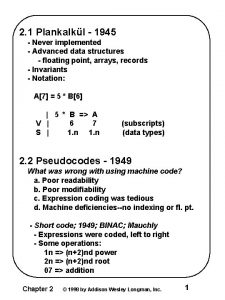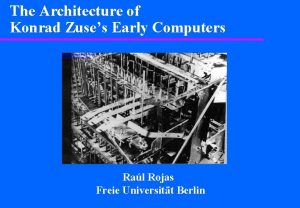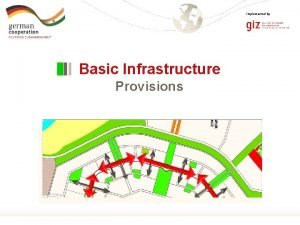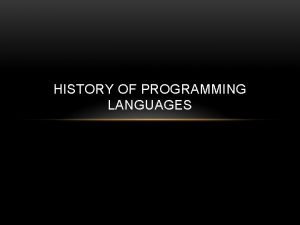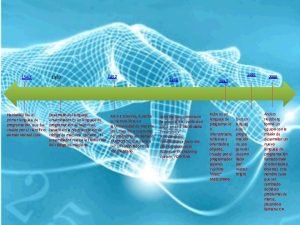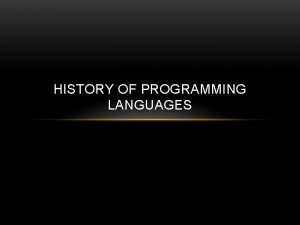Zuses Plankalkl 1945 Never implemented Had advanced data















- Slides: 15

Zuse’s Plankalkül – 1945 • Never implemented • • • Had advanced data types and structures Floating point, arrays, records, nesting in records No explicit goto statements Iteration Selection without else part Invariants and assertions • • • Sorting Graph connectivity Integer and floating point arithmetic Expressions with operator precedence Chess playing • Problems Zuse Solved • Terse Notation

Assemblers and Assembly Language • Problem with machine code? • Poor readability • Poor modifiability – addition and deletion of instructions was difficult • Expression coding was tedious • Machine deficiencies--no indexing or fl. pt. operation available • Speedcoding; 1954; IBM 701, Backus • • • Pseudo ops for arithmetic and math functions Conditional and unconditional branching Auto-increment registers for array access Interpreted – Slow! After loading the interpreter, only 700 words left for user program

The First Compiler Laning and Zierler System - 1953 • Implemented on the MIT Whirlwind computer • First "algebraic" compiler system • Subscripted variables, function calls, expression translation • Never ported to any other machine

FORTRAN I – John Backus 1957 • • • First implemented version of FORTRAN (FORTRAN 0 - 1954 - not implemented) FORmula TRANslating system First compiled high-level language Designed for the new IBM 704, which had index registers Environment of development: • • Computers were small and unreliable Applications were scientific No programming methodology or tools Machine efficiency was most important No need for dynamic storage Need for good array handling and counting loops No string handling and decimal arithmetic

Fortran IV (1960) • Fortran IV • • Explicit type declarations Logical IF statement Passing subprogram as parameters ANSI standard in 1966

Fortran I (continued) • • • Names could have up to six characters Formatted I/O User-defined subprograms No data typing statements No separate compilation Compiler released in April 1957, after 18 man months of effort • Programs larger than 400 lines rarely compiled correctly • Code was very fast • Within one year, 50% of the code written for IBM 704 machine was being developed in FORTRAN.

Fortran I – 1957 Influence of HW on Language Design • All statements of FORTRAN I were based on 704’s instruction set • 3 way branch – computed if If (EXPRESSION) L 1, L 2, L 3 • Posttest counting loop – DO L 1 I = N, M

Fortran 77 and 90 • FORTRAN 77 – 1977 • • Structured Programming Character string handling Logical loop control statement IF-THEN-ELSE statement • FORTRAN 90 – 1990 • • Modules Dynamic arrays Pointers Recursion • CASE statement • Parameter type checking

Functional Programming LISP – Mc. Carthy 1959 • LISt Processing language • AI research lab at MIT • Linguistic, psychology, and mathematics • Needed a language that: • • Process data in dynamically growing lists (rather than arrays) Symbolic computation (rather than numeric) Only two data types: atoms and lists Syntax is based on lambda calculus • Pioneered functional programming • No need for assignment • Control via recursion and conditional expressions • It is still the dominant language for AI • COMMON LISP and Scheme are contemporary dialects of LISP • ML, Miranda, and Haskell are related languages

ALGOL

ALGOL 58 – 1958 • ALGOrithmic Language • Search for a “Universal Language” • Environment of development: • FORTRAN had (barely) arrived for IBM 70 x and was owned by IBM • Many other languages were being developed, all for specific machines • No portable language; all were machine-dependent • No universal language for communicating algorithms • Goals of the language: • Close to mathematical notation • Good for describing algorithms • Machine independent, algorithmic language for use on all kinds of computers.

Algol 58 (Continued) • Language Features: • • • Concept of type was formalized Names could have any length Arrays could have any number of subscripts Lower bound could be defined Parameters were separated by mode (in & out) Subscripts were placed in brackets Compound statements (begin. . . end) Semicolon as a statement separator Assignment operator was : = ‘if’ had an ‘else-if’ clause • Never implemented • IBM was initially enthusiastic but vested interest in FORTRAN resulted in taking back all support by mid-1959

Algol 60 - 1960 • New Features: • • Block structure (local scope) Two parameter passing methods – value and name Subprogram recursion Stack-dynamic arrays – run time size definition and space allocation • No I/O • Syntax was defined in BNF

Algol 60 (Continued) • Successes: • • • It was the standard way to publish algorithms for over 20 years All subsequent imperative languages are based on it First machine-independent language First language whose syntax was formally defined in BNF Had impact on hardware design • Failure: • Never widely used, especially in U. S. • Reasons: • • No I/O and the character set made programs non-portable Too flexible, so hard to understand implement IBM’s interest in FORTRAN Formal syntax description – at that time BNF was considered strange and complicated!

Algol 68 - 1968 • Continued development of ALGOL 60 was released as Algol 68 in 1968, but it is not a superset of that language • Design is based on the concept of orthogonality • Contributions: • User-defined data structures • Reference types • Dynamic arrays (called flex arrays) • Had even less usage than ALGOL 60 • Had strong influence on subsequent languages, especially Pascal, C, and Ada
 Love never fails never gives up
Love never fails never gives up We are never never weary
We are never never weary If we had more rain our crops would grow faster
If we had more rain our crops would grow faster He never polishes his shoes so he never looks smart
He never polishes his shoes so he never looks smart God never fails meaning
God never fails meaning What can run but never walks has a mouth
What can run but never walks has a mouth What if jesus had never been born
What if jesus had never been born After i had eaten my lunch
After i had eaten my lunch I had had breakfast before i went to school
I had had breakfast before i went to school Strategy is implemented through
Strategy is implemented through Who implemented glasnost and perestroika
Who implemented glasnost and perestroika Virtual memory is commonly implemented by
Virtual memory is commonly implemented by Manuel roxas economic policies
Manuel roxas economic policies Coe 202
Coe 202 Difference between datagram and virtual circuit
Difference between datagram and virtual circuit Threads cannot be implemented as a library
Threads cannot be implemented as a library



